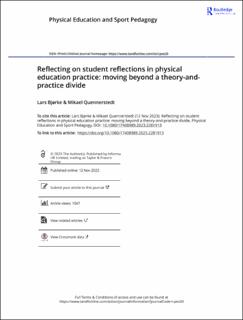| dc.contributor.author | Bjørke, Lars | |
| dc.contributor.author | Quennerstedt, Mikael | |
| dc.date.accessioned | 2024-02-16T09:32:47Z | |
| dc.date.available | 2024-02-16T09:32:47Z | |
| dc.date.created | 2023-11-12T10:54:37Z | |
| dc.date.issued | 2023 | |
| dc.identifier.citation | Physical Education and Sport Pedagogy. 2023, . | en_US |
| dc.identifier.issn | 1740-8989 | |
| dc.identifier.uri | https://hdl.handle.net/11250/3118101 | |
| dc.description.abstract | Background Although the theory/practice dualism seems difficult to deal with in physical education (PE) practice, this paper posits that there are ways in which teachers can enable students to develop holistic competencies that encapsulate elements of both theoretical and practical knowledge. We therefore seek to rethink the relationship between theory and practice in PE practice and present ways in which PE teachers can connect these forms of knowledge with their students. We do so by looking at one of the historically most favoured means of bridging theory and practice: reflection. Purpose The purpose of this paper is to contribute with knowledge about student reflection in PE practice. First, we discuss the concept of reflection to clarify how student reflection might be understood in the embodied and situated context of PE practice. Then, we reconceptualise reflection in a way that might enable teachers to bridge the gap between theory and practice in new and hopefully fruitful ways with their students. Theory and methods We draw on various theoretical traditions on reflection to present a reconceptualisation of reflection that encapsulates the practical, situated and embodied nature of PE. Theoretical discussion We present the following four key ideas pertaining to reflection that together create a framework for conceptualising student reflection in the PE context: 1) Why reflection is important: a matter of intelligent practice; 2) Students must learn to reflect – in relation to what?; 3) What should students reflect on?; and 4) The how questions: creating conditions for reflections through indeterminate situations. Drawing on these four key ideas, we present an example of how our theoretical discussions can form the following three intertwined principles for a pedagogy of student reflection in PE practice for PE teachers moving beyond a theory-and-practice divide in PE: 1) a pedagogy of becoming through reflection; 2) a pedagogy of reflecting on the plurality of embodied and situated meaning; and 3) a reflective pedagogy of enquiry and discovery. Conclusion Throughout this paper, we argue that students need to learn to reflect, we suggested how reflection could be facilitated and we proposed that the why(s), what(s) and how(s) should be the objects of student reflection in PE. It is necessary to highlight that our suggestions for a pedagogy of student reflection are not complete nor definite but could serve as points of departure for future discussions of student reflection in PE. | |
| dc.language.iso | eng | en_US |
| dc.rights | Navngivelse 4.0 Internasjonal | * |
| dc.rights.uri | http://creativecommons.org/licenses/by/4.0/deed.no | * |
| dc.title | Reflecting on student reflections in physical education practice: moving beyond a theory-and-practice divide | en_US |
| dc.title.alternative | Reflecting on student reflections in physical education practice: moving beyond a theory-and-practice divide | en_US |
| dc.type | Peer reviewed | en_US |
| dc.type | Journal article | en_US |
| dc.description.version | publishedVersion | |
| dc.source.pagenumber | 14 | en_US |
| dc.source.journal | Physical Education and Sport Pedagogy | en_US |
| dc.identifier.doi | 10.1080/17408989.2023.2281913 | |
| dc.identifier.cristin | 2195377 | |
| cristin.ispublished | true | |
| cristin.fulltext | original | |
| cristin.qualitycode | 2 | |

